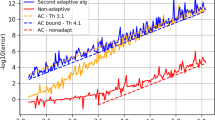Abstract
Quasi-Monte Carlo methods and lattice rules with good lattice points give rapidly “good” approximations for numerical integration, but the error estimation is intractable in practice. In the literature, a randomization of these methods, using a combination of Monte Carlo and quasi-Monte Carlo methods, has been done to obtain a confidence interval using the Central Limit Theorem. In this paper we show that for a special class of functions with small Fourier coefficients and using good lattice points, the decreasing of the variance of the combined estimator is faster than the usual one.
Similar content being viewed by others
References
Cranley, R., Patterson, T. N. L.: Randomization of number theoretic methods for multiple integration. SIAM J. Numer. Anal.13, 904–914 (1976).
Drmota, M., Tichy, R. F.: Sequences, discrepancies and applications. Lecture Notes in Mathematics, vol. 1651. Berlin Heidelberg New York Tokyo: Springer, 1997.
Fishman, G. S.: Monte Carlo: concepts, algorithms and applications. Berlin Heidelberg New York Tokyo: Springer, 1997.
Hua, L. K., Wang, Y.: Applications of number theory to numerical analysis: Berlin Heidelberg New York Tokyo: Springer, 1981.
Joe, S.: Randomization of lattice rules for numerical multiple integration. J. Comp. Appl. Math.3, 299–304 (1990).
Korobov, N. M.: On the computation of optimal coefficients. Sov. Math. Dokl.26, 590–593 (1982).
Niederreiter, H.: Random number generation and quasi-Monte Carlo methods. CBMS-SIAM 63, Philadelphia, 1992.
Niederreiter, H.: Improved error bounds for lattice rules. J. Complexity9, 60–75 (1993).
Shaw, J. E. H.: A quasirandom approach to integration in Bayesian statistics. Ann. Statist.16, 895–914 (1988).
Sloan, I. H., Kachoyan, P. J.: Lattice methods for multiple integration: theory, error analysis and examples. SIAM J. Numer. Anal.24, 116–128 (1987).
Tuffin, B.: Variance reduction technique for a cellular system with dynamic resource sharing. In: Proceedings of the 10th European Simulation Multiconference, pp. 467–471. Budapest, 1996.
Tuffin, B.: Simulation accélérée par les méthodes de Monte Carlo et quasi-Monte Carlo: théorie et applications. PhD thesis, Université de Rennes 1, 1997.
Tuffin, B.: Variance reductions applied to product-form multi-class queuing network. ACM Trans. Model. Comput. Simul.7, 478–500 (1997).
Zaremba, S. K.: Some applications of multidimensional integration by parts. Ann. Pol. Math.21, 85–96 (1968).
Zinterhof, P.: Gratis lattice points for multidimensional integration. Computing38, 347–353 (1987).
Author information
Authors and Affiliations
Rights and permissions
About this article
Cite this article
Tuffin, B. Variance reduction order using good lattice points in monte carlo methods. Computing 61, 371–378 (1998). https://doi.org/10.1007/BF02684386
Received:
Revised:
Issue Date:
DOI: https://doi.org/10.1007/BF02684386




